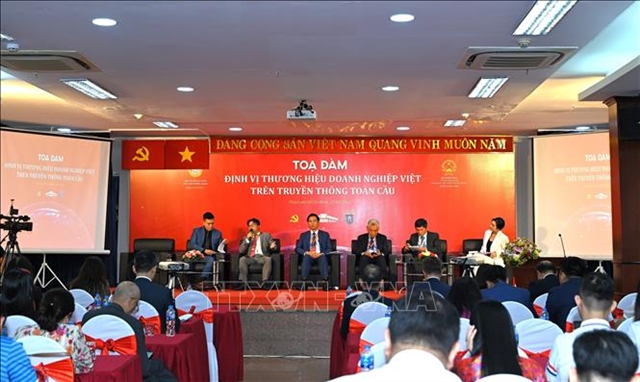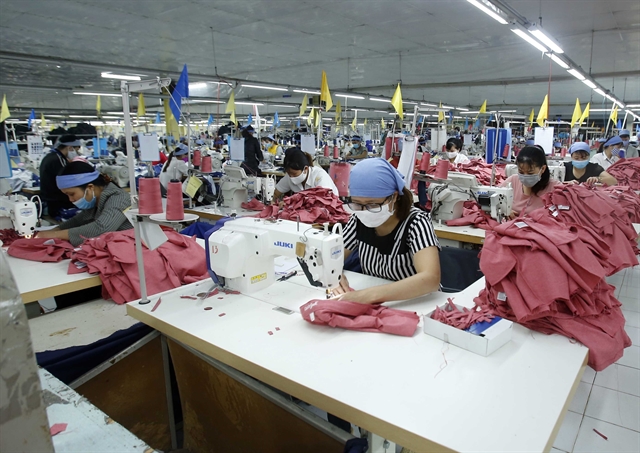 Economy
Economy

 |
| Workers at a textile factory in the northern province of Hưng Yên. — VNA/VNS Photo Phạm Kiên |
HÀ NỘI — Vietnamese textile and garment businesses have been actively promoting brand development, with many of them implementing strategies to introduce their products to the global market, according to industry insiders and experts.
Over the years, businesses have focused on brand development, creating higher value in export orders and establishing a solid position in the domestic market with "Made in Vietnam" products, gaining a strong foothold and winning over consumers in foreign markets.
For example, May 10 Corporation has recently introduced two product lines: Generos and DeTheia. Generos targeted younger customers, aiming to bring a new and dynamic style, while DeTheia offered high-end products for women.
In addition to these two product lines, May 10 has invested in designing and launching various fashion products with diverse styles, rich materials and trendy designs in line with Vietnamese and international fashion trends.
Products like Eternity GrusZ, May10 M series and the ECO product line, featuring natural materials such as silk, linen and other natural fibres, have been introduced, promoting environmental friendliness and user well-being.
Thân Đức Việt, CEO of May 10 Corporation, said the company has developed numerous collections to meet all customer needs. With a workforce of 12,000 employees, including over 300 designers, sample development and market development teams, the corporation aims to increase the proportion of ODM (original design manufacturer) and FOB (Free-On-Board, buy raw materials, manufacture, sell as finished products) in its business strategy.
In addition to exports, since 1992, May 10 has built up its brand for the domestic market. Following the OBM (original brand manufacturer) method, May 10 sells its products domestically, similar to global fashion brands. This approach has allowed the corporation to gradually expand its presence in the global market by exporting its brand instead of acting as a FOB or ODM for foreign brands.
Similarly, Vietnam Textile and Garment Group (Vinatex) has also successfully established its position in the domestic market with well-known brands such as Viettien, Viettien Smartcasual San Sciaro, Manhattan, T-up, Vietlong and Camellia.
With over 1,300 retail stores nationwide, Bùi Văn Tiến, CEO of Vinatex, said the company aims to continue developing new lines of products to achieve 10-15 per cent of the total export value of the Vietnamese textile and garment industry by 2030, with a turnover target of US$1.2-1.4 billion.
Design focus
Proactively sourcing raw materials and emphasising design could add additional value, said Lê Tiến Trường, chairman of the Board of Directors of Vinatex. He said although textile and garment exports remain a key economic sector, a limited supply of domestic raw materials reduces the industry's competitiveness.
To address and overcome this issue, there is a need to focus on developing domestic raw material sources, aligned with green and circular economy trends, meeting stricter standards regarding rules of origin, as well as potential additional taxes that may be applied in the future, such as EPR (extended producer responsibility) and CBAM (carbon border adjustment mechanism).
According to the chairman, the current domestic fabric production capacity only meets 36 per cent of demand, with imported fabrics holding a 64 per cent market share. Therefore, Việt Nam needs a comprehensive strategy to diversify the supply chain to ensure the sustainability of the textile and garment sector.
"We have the advantage of being a latecomer. We already have a large raw material production system, and now is the time to shift raw material production towards compatibility with a circular economy. While the actual proportion of raw material production is not yet high, the opportunity is in new investments that need to be made sooner rather than later," said Trường.
Hoàng Xuân Hiệp, principal of the Hà Nội University of Industrial Textiles, stressed the crucial role of design in fashion development and called for fashion design programmes to be equipped with new ideas, including virtual 3D software with integrated material selection, basic product design, and virtual fashion show organisation for customers to view and review models and make adjustments on virtual models.
Additionally, universities should introduce all-new global trends in the fashion industry, such as green fashion and recycled fashion, to train high-quality human resources capable of applying Industry 4.0 achievements to design and production.
Industry experts advised that businesses should proactively invest in modern equipment to increase productivity and transition from cut-and-sew methods to FOB, ODM and OBM methods to enhance product value and quality. Furthermore, continuing the trend of green production, energy savings, renewable energy and environmental protection, will help make these criteria competitive advantages for the Vietnamese textile and garment industry. — VNS




